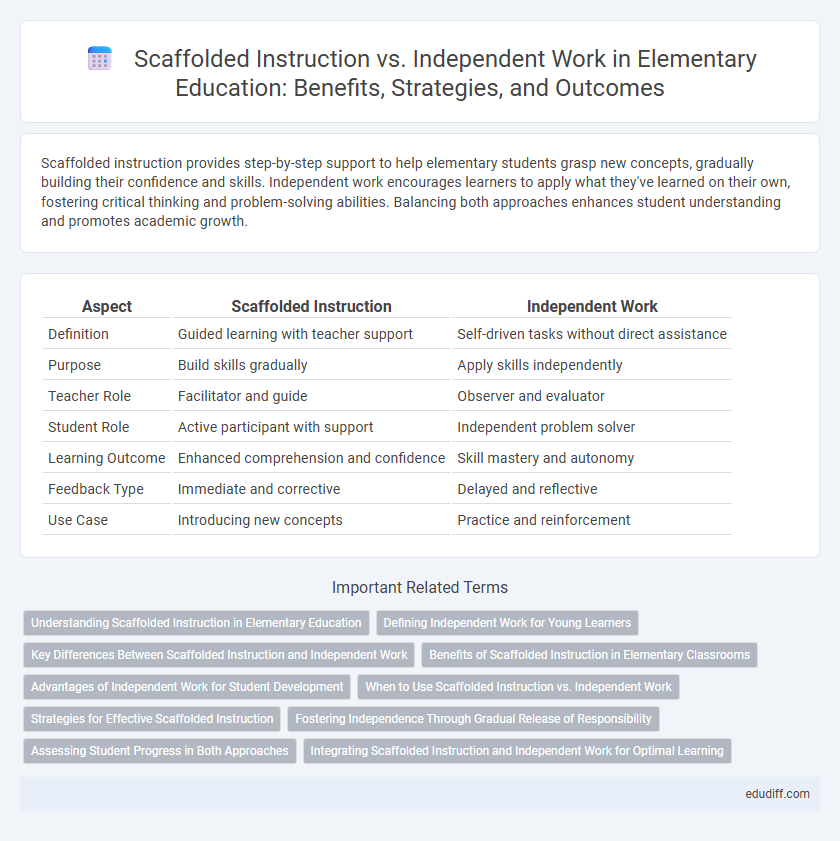Scaffolded instruction provides step-by-step support to help elementary students grasp new concepts, gradually building their confidence and skills. Independent work encourages learners to apply what they've learned on their own, fostering critical thinking and problem-solving abilities. Balancing both approaches enhances student understanding and promotes academic growth.
Table of Comparison
| Aspect | Scaffolded Instruction | Independent Work |
|---|---|---|
| Definition | Guided learning with teacher support | Self-driven tasks without direct assistance |
| Purpose | Build skills gradually | Apply skills independently |
| Teacher Role | Facilitator and guide | Observer and evaluator |
| Student Role | Active participant with support | Independent problem solver |
| Learning Outcome | Enhanced comprehension and confidence | Skill mastery and autonomy |
| Feedback Type | Immediate and corrective | Delayed and reflective |
| Use Case | Introducing new concepts | Practice and reinforcement |
Understanding Scaffolded Instruction in Elementary Education
Scaffolded instruction in elementary education involves providing structured support tailored to students' developmental levels, gradually withdrawing assistance as learners gain confidence and skills. This method enhances comprehension and engagement by breaking complex tasks into manageable steps with guided practice. In contrast to independent work, scaffolded instruction fosters deeper understanding through targeted feedback and collaborative learning opportunities.
Defining Independent Work for Young Learners
Independent work for young learners refers to tasks completed by students without direct teacher assistance, encouraging self-reliance and problem-solving skills. It involves age-appropriate activities that allow children to apply learned concepts independently, fostering confidence and autonomy. Effective independent work balances challenge and support to ensure young learners remain engaged and motivated.
Key Differences Between Scaffolded Instruction and Independent Work
Scaffolded instruction provides structured support through guided practice, hints, and feedback to help elementary students build understanding and skills step-by-step. Independent work requires students to apply what they've learned without assistance, fostering self-reliance and critical thinking. The key difference lies in the presence of teacher support during scaffolded lessons versus student autonomy during independent tasks.
Benefits of Scaffolded Instruction in Elementary Classrooms
Scaffolded instruction in elementary classrooms enhances student comprehension by providing structured support that gradually fades as learners gain mastery, promoting confidence and autonomy. This approach addresses diverse learning needs through tailored guidance, improving engagement and retention of key concepts. Research shows scaffolded instruction leads to higher academic achievement and fosters critical thinking skills essential for future independent work.
Advantages of Independent Work for Student Development
Independent work in elementary education enhances student autonomy and critical thinking by encouraging self-paced learning and problem-solving. It fosters a sense of responsibility and confidence as students manage their tasks without constant guidance. This approach promotes deeper understanding and retention by allowing learners to explore concepts independently and apply skills in diverse contexts.
When to Use Scaffolded Instruction vs. Independent Work
Scaffolded instruction is ideal during the initial stages of learning when students need guided support to grasp new concepts and develop foundational skills. Independent work becomes effective once students demonstrate understanding and are ready to apply knowledge autonomously, fostering critical thinking and self-regulation. Teachers can assess student readiness through formative assessments to determine the appropriate balance between scaffolded instruction and independent tasks.
Strategies for Effective Scaffolded Instruction
Effective scaffolded instruction in elementary classrooms involves breaking tasks into manageable steps, using visual aids, and providing clear modeling to support student understanding. Teachers gradually reduce support as students demonstrate mastery, promoting independence and confidence. Incorporating frequent formative assessments helps tailor scaffolds to individual learning needs, enhancing overall comprehension and engagement.
Fostering Independence Through Gradual Release of Responsibility
Scaffolded instruction gradually shifts learning responsibility from teacher to student, promoting independence through guided practice before moving to independent tasks. This approach aligns with the gradual release of responsibility model, which transfers cognitive load and decision-making skills incrementally. By embedding scaffolds such as prompts, modeling, and feedback, students develop confidence and autonomy in completing independent work over time.
Assessing Student Progress in Both Approaches
Scaffolded instruction allows teachers to continuously monitor and support student progress through targeted feedback and formative assessments, ensuring students master each step before moving forward. Independent work provides opportunities for students to demonstrate their understanding and apply skills independently, which helps assess their ability to transfer knowledge without immediate guidance. Combining data from formative assessments in scaffolded settings and summative evaluations during independent tasks offers a comprehensive view of student learning and growth.
Integrating Scaffolded Instruction and Independent Work for Optimal Learning
Integrating scaffolded instruction with independent work promotes deeper comprehension and skill mastery in elementary students by gradually transferring responsibility from teacher to learner. Scaffolded instruction provides structured support through guided practice and modeling, while independent work encourages application and self-regulation within a familiar framework. This balanced approach enhances engagement, builds confidence, and adapts to diverse learning needs, maximizing overall academic success.
Scaffolded Instruction vs Independent Work Infographic

 edudiff.com
edudiff.com